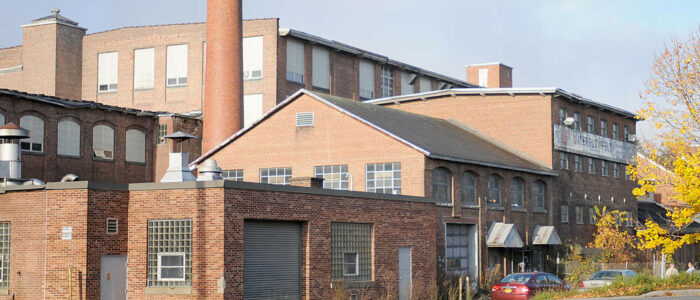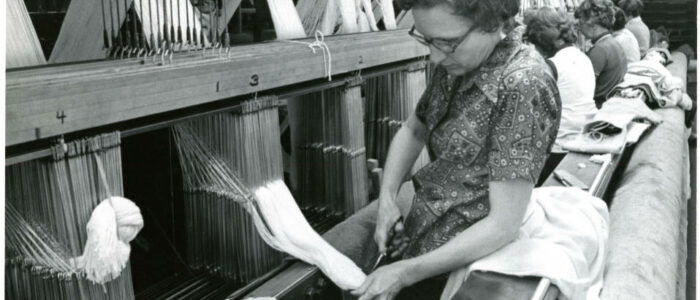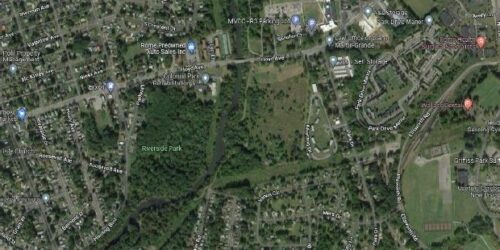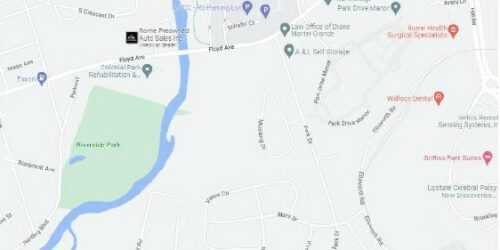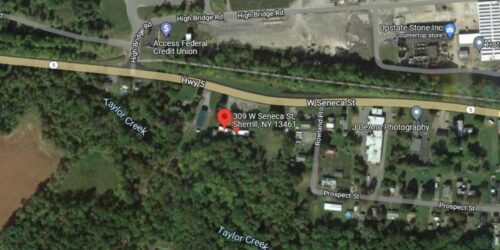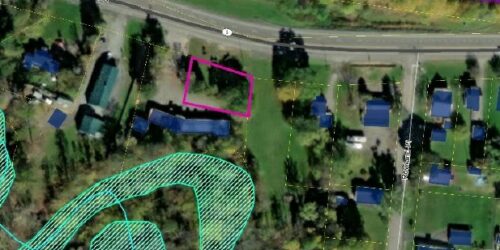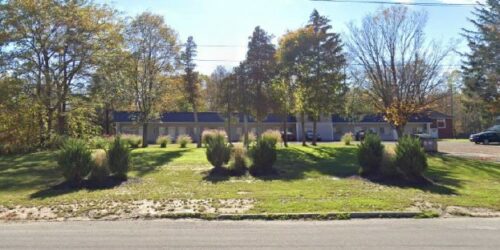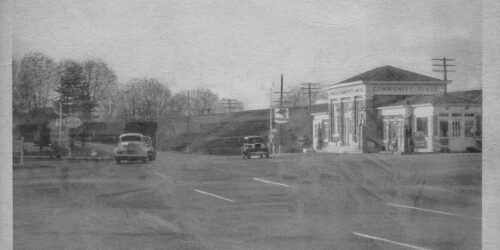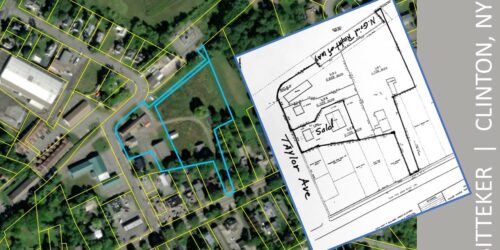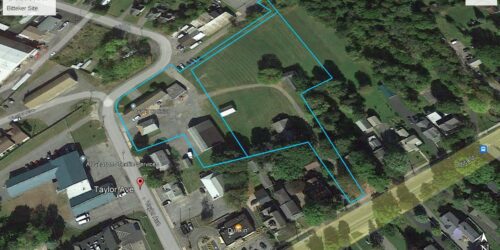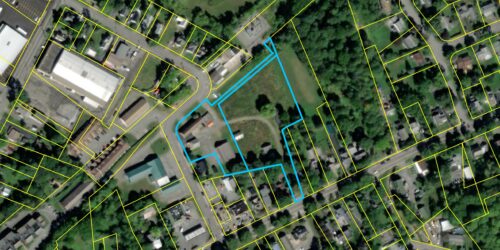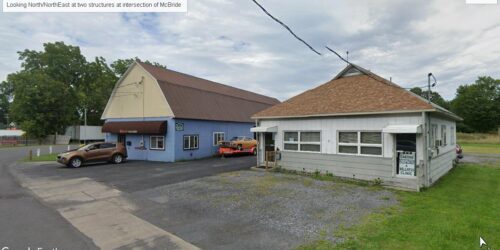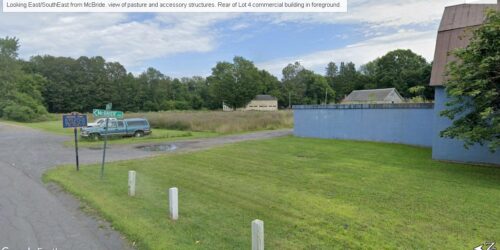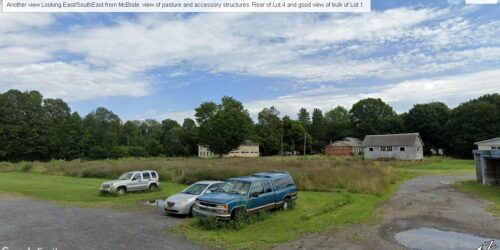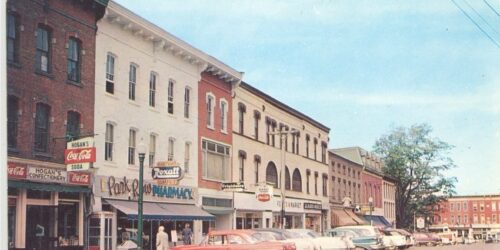BROWNFIELD REDEVELOPMENT
EPA Assessment Grant Request for Qualifications
Mohawk Valley EDGE is issuing a request for qualifications (RFQ) for qualified environmental professionals (QEPs) to conduct Phase I and Phase II ESAs, among other activities, as part of an EPA brownfields assessment grant. The full RFQ can be found here.
EDGE is pleased to showcase their Brownfields Cleanup Revolving Loan Fund!
MORE INFO
What is a Brownfield?
It is a property whose expansion, redevelopment, or reuse may be complicated by the presence (or potential presence) of hazardous substance, pollutant, or contaminants. Frequently, they are former industrial properties where operations may have resulted in environmental impairment.
Why redevelop Brownfields?
Redevelopment of these sites result in new public spaces, new job opportunities, new urban real estate, and, ultimately, the reversal of decades of environmental injustice. The removal of the blight, alone, is addition by subtraction; but the benefits run much deeper. Adaptive reuse of vacant, contaminated, and underutilized properties requires greater up-front investment, but also carries the most sustainable value proposition for the region – especially since these sites are in our population centers, along our waterfronts, and have proximity to abundant infrastructure and workforce. For more information on brownfields, please visit https://www.epa.gov/brownfields.
EDGE–USEPA Brownfields Assessment and Revolving Loan Fund Project
In 2022, Mohawk Valley EDGE received a $300,000 grant from the Environmental Protection Agency (EPA) to inventory, assess, investigate, and develop remediation plans for brownfields across Oneida County. As of December 2022, 13 Phase I Environmental Site Assessments (ESA) are underway or completed with this USEPA funding. Sites in Rome, Utica, Sherrill, Sylvan Beach, Oriskany, and Boonville are included. For more on reassessing contaminated sites and brownfields in our area, including full details from the Environmental Protection Agency, quick facts on projects, and other updates, see below.
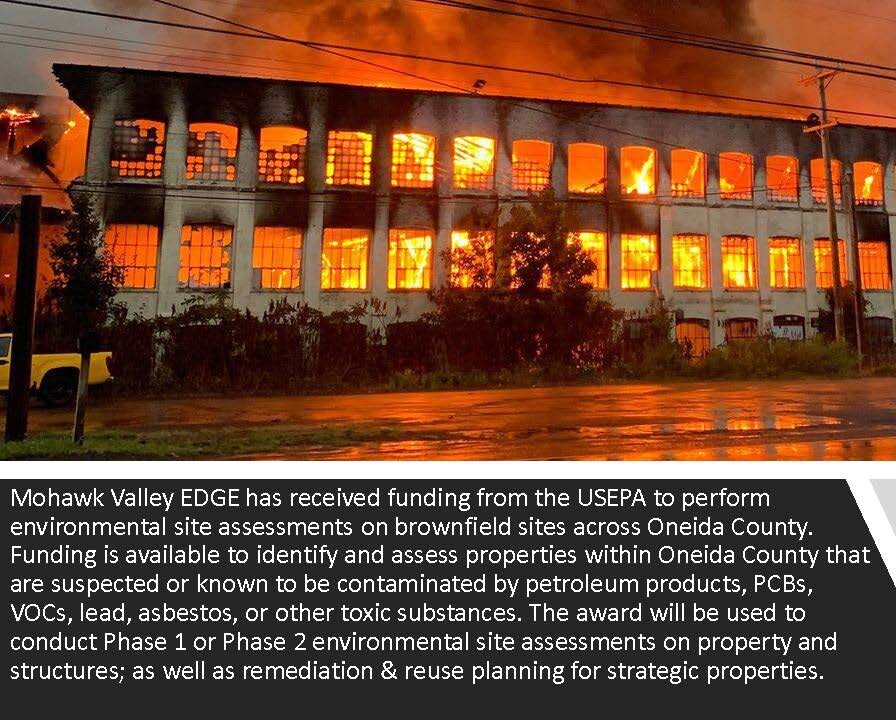
What’s Next in 2024?
As a result of rigorous site assessments and community engagement strategies, EDGE’s program has unlocked the doors to new revitalization opportunities across Oneida County. Some sites have been elevated to ESA Phase II and strategic planning efforts for 2023, others have become applicants for Restore NY, and one site has been referred to NYSDEC Cleanup Program. And this is just the beginning: EDGE will continue to work with communities to eradicate these notorious brownfields to reverse the cycle of disinvestment, restore environmental justice, and create new, taxable, vibrant real estate in our cities, villages, and towns.
Grant Summary for Brownfield Site Assessments, Oneida County
Oneida County has a long history of industrial and commercial uses that left behind a legacy of contamination. The goals of the EPA grant are to prioritize and assess strategic brownfield properties, return tax delinquent brownfield sites to productive use, and facilitate brownfields redevelopment. Overgrown brownfield sites and decaying structures create challenges and opportunities for stabilization and revitalization strategy, turning blight to bright developments.
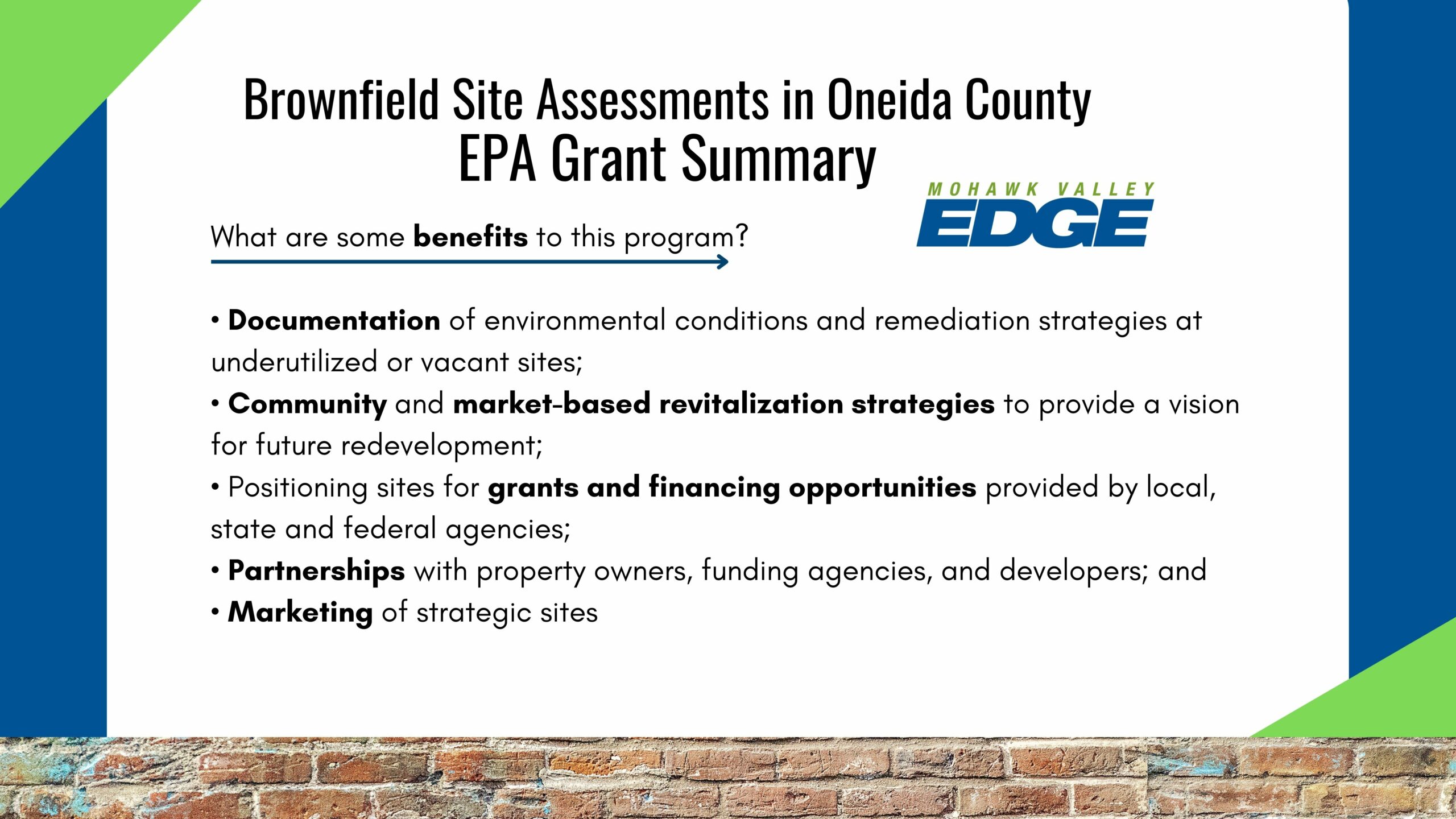
Map of EPA Assessment Projects
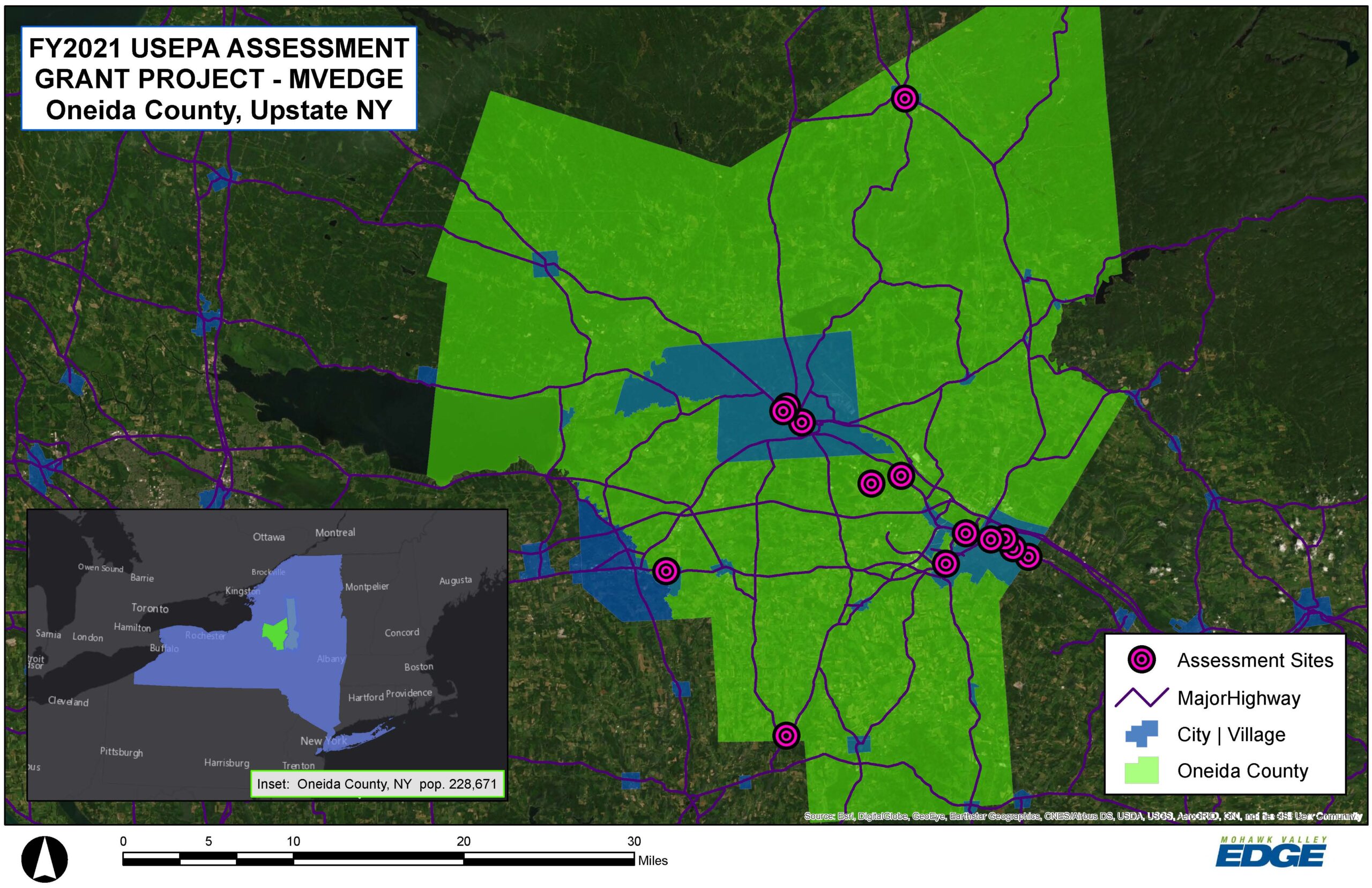
Our Featured Brownfield Sites
Each of these featured sites throughout Oneida County have begun stages of further clean-up and development. We hope to solicit more community feedback on revitalizing these spaces as project plans move forward. Each site’s transformation will contribute to the:
- Protection of human health and the environment
- Promotion of economic development
- Enabled creation of, preservation of, or addition to: parks, greenways, undeveloped property, other recreational property, or other property used for nonprofit purposes
Waterbury Felt
Oriskany, NY
The nearly 500,000 square foot complex of structures, formerly a woolen felt mill that employed 300+ people in the 1800s and 1900s, was purchased by a private, local businessman in 2014. The site is, by far, the largest structure in the Village’s downtown area, and continues to deteriorate because of vacancy. Ongoing impacts include threats to adjacent residential and commercial properties, yet show promising potential for the creation of parks, greenways, undeveloped property, recreational property, or property used for nonprofit purposes.
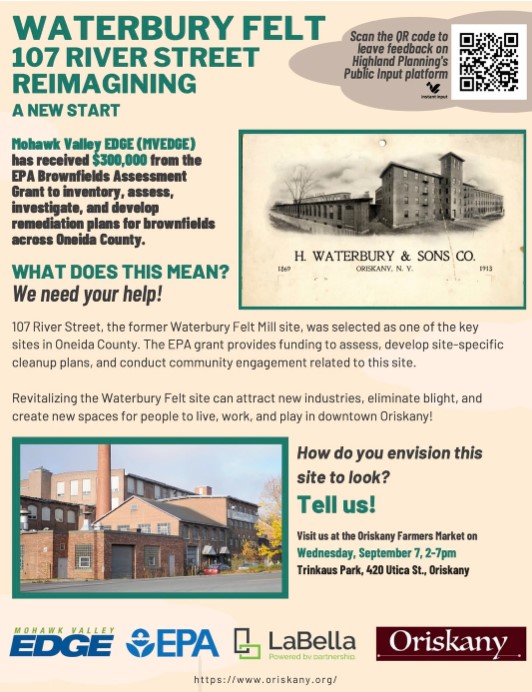
If you are interested in giving your feedback on the future of Waterbury Felt, check out our site survey (“tell us what’s on your mind!”).
As of mid-September 2022, the site has been the topic of two public-based community feedback opportunities. A public farmers’ market booth was spearheaded by LaBella Associates, an environmental planning firm, and MVEDGE to gather on the ground public comments. Further discussion took place at a public forum fostered by the Village of Oriskany, led by Village Clerk and Oriskany Museum Director Alexis Albright. Many residents of Oriskany have a personal connection to the mill, having worked or known those who worked on-site. The site remains a community fixture, with many commenting on its blight and hazards to the area landscape. As of December 2022, the mill is in Phase II Assessment stage.
Former Wright Park Manor
Rome, NY
The site was formerly occupied by Wright Park Manor– a public housing complex constructed in the 1970s and eventually demolished in the early 2000s–and is currently owned by Rome Industrial Development Corporation (RIDC). A notation indicated that there were once 200 residences at Wright Park Manor. These structures have since been demolished.
The property was purchased out of foreclosure by the City of Rome in 2014 and purchased by RIDC in 2022. RIDC is in negotiations with the YMCA of the Greater Tri-Valley to grant an Option to Purchase in hopes of constructing a new recreational/wellness campus. This site is directly across from Mohawk Valley Community College campus and immediately adjacent to Park Drive Manor, Rome’s largest affordable housing neighborhood. In addition to the YMCA, the masterplan calls for construction of a multi-purpose public athletic field, greenspace, and pedestrian trail connections to the Mohawk River Trail.
301 West Seneca
Sherrill, NY
This site is the former Alaskan Oil, a gas station situated in the city of Sherrill. The site was formerly occupied by a gas station/service station on NY Route 5 in the City of Sherrill. The property was acquired by the City through tax foreclosure and currently owned by the City. The structures were demolished and the current status is vacant land.
This site has potential to contribute to the local tax base if revitalized. Adjacent to the property are commercial, residential, and industrial uses, including retail and dining in the immediate vicinity. Part of the site could serve as a pedestrian connection between downtown Sherrill and surrounding businesses and neighborhoods. Additionally, the site borders Taylor Creek to the south – a popular fishing and recreational stream.
Bitteker Site
Clinton, NY
This site is the Bitteker property off Taylor Avenue/Utica Street in Clinton. EDGE is working with the Clinton-Kirkland Improvement Corporation (CKIC), the Village, and the owners of the Bitteker parcels to develop a remediation and revitalization strategy for the property. It all starts with clear, reliable information – and that is where the USEPA grant comes in.
The CKIC is a nascent non-for-profit comprised entirely of volunteers seeking a higher and better use for the group for some of the vacant property. The USEPA Assessment grant is filling a critical financial gap, allowing the CKIC to take the first step towards revitalization.
Key Points: US Environmental Protection Agency News Release
EPA to Award $10.5 Million to Address Contaminated Sites in New York
Article originally published on May 12th, 2022 | Contact Information: John Senn, 212-637-3662 or senn.john@epa.gov
NEW YORK (May 12, 2022) – Today, the Biden Administration through the U.S. Environmental Protection Agency (EPA) announced that it is awarding $254.5 million in Brownfields Grants to 265 communities, including 12 grants totaling $10.5 million across New York State. Today’s grants are supported by President Biden’s Bipartisan Infrastructure Law, which provides a total of $1.5 billion to advance environmental justice, spur economic revitalization, and create jobs by cleaning up contaminated, polluted, or hazardous brownfield properties. Brownfield projects can range from cleaning up buildings with asbestos or lead contamination, to assessing and cleaning up abandoned properties that once managed dangerous chemicals. Once cleaned up, former brownfield properties can be redeveloped into productive uses such as grocery stores, affordable housing, health centers, museums, parks, and solar farms.
Applicants selected for funding in New York are:
- Chautauqua County Industrial Development Agency, Revolving Loan Fund Grant of $600,000
- City of Dunkirk, Assessment Grant of $300,000
- City of Gloversville, Assessment Grant of $500,000
- Village of Greenwich, Assessment Grant of $200,000
- Herkimer County Industrial Development Agency, Assessment Grant of $500,000
- Mohawk Valley Economic Development Growth Enterprises Corporation, Revolving Loan Fund Grant of $1,000,000
- City of New York, Revolving Loan Fund Supplemental Grant of $1,000,000
- Niagara County, Revolving Loan Fund Supplemental Grant of $3,900,000
- Oswego County, Assessment Grant of $500,000
- Safe Harbors of the Hudson, Inc., of Newburgh, Assessment Grant of $500,000
- Wayne County, Revolving Loan Fund Grant of $1,000,000
- WCBC North, LLC, of Arcade, Cleanup Grant of $500,000
Since its inception in 1995, EPA’s investments in brownfield sites have leveraged more than $35 billion in cleanup and redevelopment. This has led to significant benefits for communities across the country. For example:
- To date, this funding has led to more than 183,000 jobs in cleanup, construction, and redevelopment and more than 9,500 properties have been made ready for reuse.
- Based on grant recipient reporting, recipients leveraged on average $20.43 for each EPA Brownfields dollar and 10.3 jobs per $100,000 of EPA Brownfields Grant funds expended on assessment, cleanup, and revolving loan fund cooperative agreements.
- In addition, an academic peer-reviewed study has found that residential properties near brownfield sites increased in value by 5% to 15% as a result of cleanup activities.
- Finally, analyzing data near 48 brownfields, EPA found an estimated $29 million to $97 million in additional tax revenue for local governments in a single year after cleanup—2 to 7 times more than the $12.4 million EPA contributed to the cleanup of those brownfields sites.
Interested in our ongoing projects?
Contact MVEDGE!
Marc Barraco, Chief Administrative Officer: mbarraco@mvedge.org
(585) 471-0273
Please Note: Title VI of the Civil Rights Act of 1964
Title VI of the Civil Rights Acts of 1964 provides that no person in the United States shall, on the grounds of race, color, or national origin, be excluded from participation in, be denied the benefits of, or be subjected to discrimination under any program or activity receiving Federal financial assistance. The Act goes on to explain that the statute shall not be construed to authorize action with respect to any employment practice of any employer, employment agency, or labor organization (except where the primary objective of the Federal financial assistance is to provide employment). Section 13 of the 1972 Amendments to the Federal Water Pollution Control Act provides that no person in the United States shall on the ground of sex, be excluded from participation in, be denied the benefits of, or be subjected to discrimination under the Federal Water Pollution Control Act, as amended. Employment discrimination on the basis of sex is prohibited in all such programs or activities. Section 504 of the Rehabilitation Act of 1973 provides that no otherwise qualified individual with a disability in the United States shall solely by reason of disability be excluded from participation in, be denied the benefits of, or be subjected to discrimination under any program or activity receiving Federal financial assistance. Employment discrimination on the basis of disability is prohibited in all such programs or activities. The Age Discrimination Act of 1975 provides that no person on the basis of age shall be excluded from participation under any program or activity receiving Federal financial assistance. Employment discrimination is not covered. Age discrimination in employment is prohibited by the Age Discrimination in Employment Act administered by the Equal Employment Opportunity Commission. Title IX of the Education Amendments of 1972 provides that no person in the United States on the basis of sex shall be excluded from participation in, be denied the benefits of, or be subjected to discrimination under any education program or activity receiving Federal financial assistance. Employment discrimination on the basis of sex is prohibited in all such education programs or activities. Note: an education program or activity is not limited to only those conducted by a formal institution. 40 C.F.R. Part 5 implements Title IX of the Education Amendments of 1972. 40 C.F.R. Part 7 implements Title VI of the Civil Rights Act of 1964, Section 13 of the 1972 Amendments to the Federal Water Pollution Control Act, and Section 504 of The Rehabilitation Act of 1973.
MV EDGE’s designated civil rights coordinator is the chief administrative officer (CAO)

